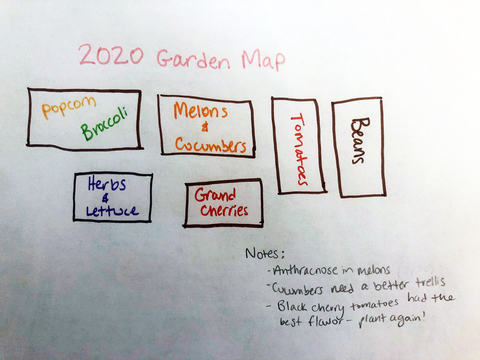Prepare your vegetable garden for winter
UNIVERSITY OF MINNESOTA EXTENSION - www.extension.umn.edu
Fall is an important time to lay the seeds of success for next year’s garden. By taking some time to clean up your garden and tools and make a plan for nutrient management, you can save yourself time and energy next spring.
Sanitation and crop rotation
Make a map of your garden with this year’s crops
Make a map of your garden
Do you have a map of this year’s garden? If not, make one now while it’s fresh in your mind. Remembering where you planted things this year can help you design a good rotation for next year.
It’s a good idea to keep garden maps for 3 or 4 years so that you can avoid planting annual plants within the same family in the same spot for a few years.
A good crop rotation helps to balance nutrient depletion from the soil and helps to reduce disease pressure. It’s also a good idea to note any problems on this year’s map such as melons had Alternaria so that you will remember to look for resistant varieties next year.
Remove or bury debris
Many pathogens can overwinter in plant residues, so it’s a good idea to either chop and bury debris or to remove vegetables from the garden. This is especially true for plants that experienced significant disease pressure this year such as lilacs or tomatoes.
That said, keep pollinators and insects in mind when cleaning up your garden. If you have perennial or flower strips, leave some stems in place for stem nesting bees.
For more tips see this UMN Extension video on fall cleanup for pollinators.
Clean your tools, wash any seeding trays
Fall is a great time to clean your tools before putting them away for the winter.
- Tools can carry plant pathogens, so they should be cleaned and sterilized regularly.
- Proper tool care will also keep your tools in good shape for many years.
- Make sure to clean and sanitize any trays you used for seeding, and any pots you plan to use again next year.
See our comprehensive guide on cleaning and sanitizing garden equipment.
Prepare your soil
Get a soil test
Gardeners should test their soil at least every three years, and fall is a great time to take a test. You’ll receive results in a few weeks, which gives you the whole winter to make a plan for nutrient management in 2021.
Researchers at the University of St. Thomas reported in a 2019 paper that garden plots that rely primarily on compost inputs can have too much phosphorus, which can result in soil and water pollution. Testing your soil regularly can help you ensure that your plants are getting what they need without damaging the environment.
Plant a cover crop or add mulch
Most soil should not be left uncovered. Keeping the soil covered is key to soil health.
While it’s now too late in most of the state to plant a cover crop that will die over the winter, there’s still time to plant a winter cereal like rye, wheat or triticale. These cover crops must be killed in the spring before you plant your garden.
Another approach is to simply add leaves, straw or other organic material to your garden beds. This will help to absorb water during heavy rainstorms and will help to prevent erosion and runoff of soil particles.
Spend some time with your compost
Many compost bins become very nitrogen-heavy if your main source of compost is food scraps. Thankfully, fall provides an abundance of organic matter that is high in carbon, which can balance out nitrogen-heavy food scraps.
Take some time to read about composting best practices. For a more in-depth look at carbon to nitrogen ratios in various sources of compost from leaves to coffee grounds, check out this guide from Cornell.
Consider amendments carefully
Many garden blogs will tell you to add compost and manure now. However, while the soil is still warm in the fall, you risk nutrient leaching and runoff, particularly with nitrogen.
If you’re applying manure, wait until the soil is 50 degrees or cooler, and work it into the soil immediately. The longer it sits on the surface, the more likely the nitrogen is to volatilize or evaporate off of the surface.
The Minnesota Department of Agriculture has a handy map tool to tell you the temperature of your soil at a depth of 6 inches. Use it to help you decide when to apply manure.
For compost, follow the same general rules, but also consider simply waiting until spring to apply it. If you do wait until spring, make sure it is fully composted to prevent any food safety issues.

